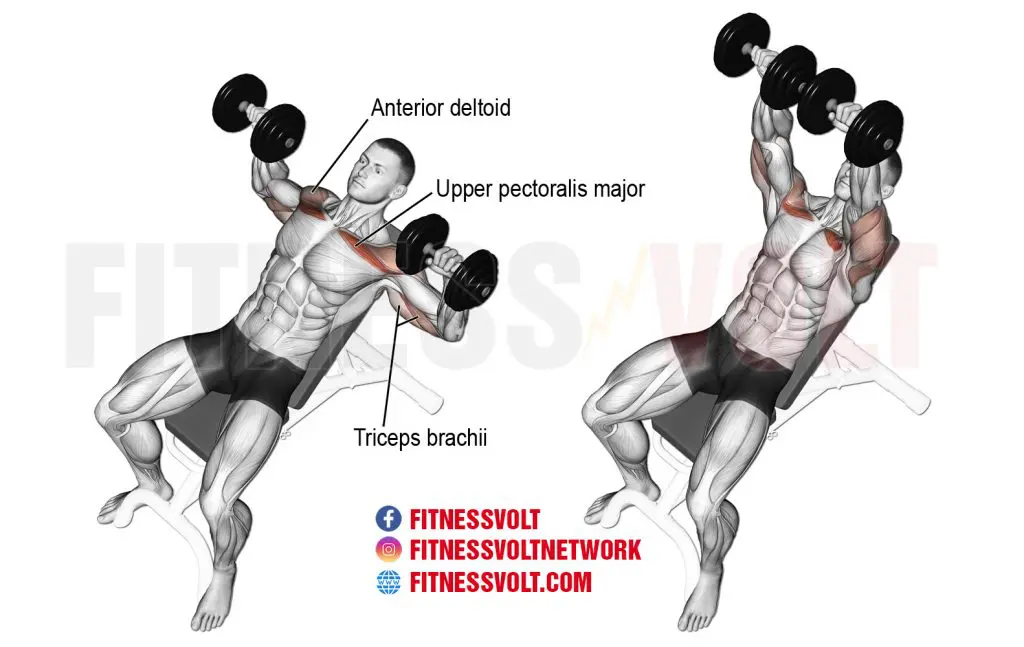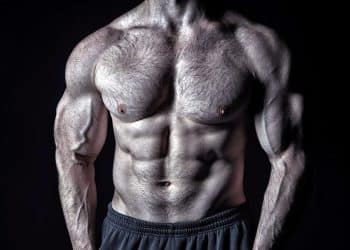When it comes to building muscle and getting in shape, dumbbells are undeniably the most versatile tool available. Why?… Because you’re not restricted or bound to one position, area, exercise, etc.
For example, when you do a dumbbell chest workout, your limbs are free to move more naturally, you can get a better chest squeeze (adduction of the arms), and you’re able to train through a larger range of motion. Dumbbells can also be better for your shoulders due to a freer movement and they’re great for identifying and correcting muscle imbalances.
In addition, you activate more stabilizer muscles than you would if you were using a barbell. So, if you’re not sold on the benefits of using dumbbells then we don’t know what to tell you!
But if you’re convinced, we have a solid dumbbell chest workout routine that’s sure to level up your chest gains if you can stick with it for four weeks…
The Workout Routine
We’re going to have to be strategic here to get the best gains possible in just four weeks. Which means, we’ll have to maximize the advantages that dumbbells offer. But overall training volume will also be key for this dumbbell chest workout.
Why is training volume so important? Because research shows that “muscle hypertrophy follows a dose-response relationship, with increasingly greater gains achieved with higher training volumes“. (1, 2)
Level Up Your Fitness: Join our 💪 strong community in Fitness Volt Newsletter. Get daily inspiration, expert-backed workouts, nutrition tips, the latest in strength sports, and the support you need to reach your goals. Subscribe for free!
We recommend training the chest twice per week as to not allow for too long of recovery in between workouts. To grow, you have to continually provide a stimulus, especially if you’re a natural lifter who depends on maximizing protein metabolism which elicits muscle repair following resistance training. (3)
You should allow for at least 48-72 hours of recovery in between each chest workout. Sets and reps will vary but we’ll provide this information next to the exercises.
Some key tips: Focus on squeezing and contracting your chest, getting a good stretch at the bottom, and keeping tension on the muscles. We want to maximize hypertrophy by encouraging as much stress on the muscles as possible. This also means rest times will be shorter as we want to keep stimulating and causing micro-tears in the muscles.
Here’s the dumbbell chest workout…
Make sure to warm-up with at least two progressive sets before starting the workout. So, since the first exercise is the incline dumbbell press, do two warm-up sets which is all you need before you begin the workout. For example, do one set at 40% of your one-rep max followed by another at 60% for your warm-up sets.
The sets and reps we’ve listed below are the working sets. Use a challenging weight for each exercise and do your best to choose a weight that’ll allow you to reach failure for the recommended rep ranges. Remember, do this workout twice per week for one month.
Incline dumbbell chest press
The incline press is one of the best chest exercises for building mass and emphasizing the upper chest near the clavicle. You can go pretty heavy with this movement too.

To do it:
- Adjust the bench at a 30 to 45-degree angle.
- Use your legs to help kick the dumbbells back one at a time while lying back on the bench simultaneously.
- Hold the dumbbells by your armpits at about mid-chest level with palms facing away from you. Then tuck your elbows slightly so your arms at a 45-degree angle to your sides.
- Arch your back slightly, retract your shoulder blades and flex your lats.
- Press the dumbbells leading with your thumbs by tilting them upward until your arms are extended. Bring the dumbbells close together but don’t allow them to touch and squeeze your pecs.
- Lower the weight until you feel a stretch in your chest and repeat.
Perform 3 sets x 8-10 reps. Rest 45 seconds between sets.
Dumbbell press to fly
This next exercise is a hybrid of the dumbbell press and dumbbell fly. For the first part of each rep, you’ll perform the eccentric (negative) portion of the fly for a more pronounced stretch (important for growth). But then, you’ll bring your arms together and finish with the press which allows you to move more weight (the best of both worlds).
To do it:
- Lie on a flat bench and press the dumbbells straight up.
- Arch your lower back, retract your shoulder blades and flex your lats.
- Turn your wrists so each one is between a neutral and pronated grip at an angle.
- Bend your elbows, then lower the dumbbells by opening up your arms as if you were giving someone a hug.
- When you feel a deep stretch in your chest muscles, move the dumbbells toward your chest and press them straight up squeezing your chest throughout.
- Repeat.
Perform 3 sets x 10-12. Rest 45 seconds between sets.
Standing single-arm dumbbell fly
Here’s an effective dumbbell exercise that you don’t see too often. It’s a fly variation that many people utilize to get an even better chest contraction when compared to the standard dumbbell fly using a bench. That’s because gravity is always working against you in this variation. Not to mention, it’s probably a stimulus you aren’t used to. It’s a great overall chest movement.
Use a moderate weight here and focus on getting the perfect chest contraction.
To do it:
- Hold onto a sturdy object with one hand while holding the dumbbell with the other. Keep your feet together next to the object.
- Lean away from the object so that your non-working arm is supporting your bodyweight.
- Bend the elbow of the arm holding the weight slightly and raise the dumbbell up and across while contracting your chest muscles.
Perform 2 sets x 8-10 reps. Rest 45 seconds between sets.
Decline push-up
You should be pretty burnt out from the previous exercises. So, we’ll do some push-ups but with your feet elevated for increased difficulty. This shifts the emphasis on the upper pecs and it’s more challenging than a basic push-up.
To do it:
- Elevate your feet on a bench, chair, or anything raised off the ground at a similar height to these objects.
- Place your hands shoulder-width on the floor so that your palms are directly next to your lower chest.
- Keep your entire body straight, shoulder blades retracted, and flex your lats. Keep your elbows slightly tucked in toward your torso.
- Lower yourself down until your chest is a few inches from the floor then press yourself back up while squeezing your pecs, then repeat.
Perform 2 sets to failure. Rest 30 seconds between sets.
Incline push-up
For the last exercise, you’ll elevate your upper body onto something which emphasizes the lower chest. You’ll perform 2 sets of incline push-ups to failure.
Rest 30 seconds between sets.
And that’s it! Twice a week for one month.
Frequently Asked Questions
Can dumbbells build as much muscle compared to using a barbell?
You can absolutely build similar muscle gains using a dumbbell compared to a barbell. Now, you may not build as much total and bilateral strength when compared to using a barbell.
But, the stability requirements, freer range of movement and versatility mean the dumbbell offers many benefits of its own where building muscle is concerned.
What are the best dumbbell chest exercises?
Presses and fly variations are among the most effective chest dumbbell exercises you can do for building muscle and strength.
Flat, incline, and decline presses are all recommended for building mass and maximum strength. Different fly variations are excellent muscle builders too although you won’t build as much strength when compared to a press.
Are dumbbell chest exercises safer than barbell chest exercises?
Well, that depends on several factors such as the individual’s structural health, lifting technique, and amount of weight used.
Dumbbells allow for an overall freer range of movement which is a big plus when compared to using a barbell. So, your joints aren’t restricted to one position.
But, this can also cause a lack of limb control which could cause injury especially if using too much weight and not doing an exercise correctly.
Both have their pros and cons but if you train smart and safe, you can avoid injuries.
Wrapping Up
This is a great dumbbell chest workout for those looking to make some visual improvements. You’ll do five exercises, twice a week for one month. The additional volume and variety can shock some new growth into your pecs.
If you’re used to training with this much volume then you may not benefit as much. But for most people, the nature of this workout should be enough to elicit results!








